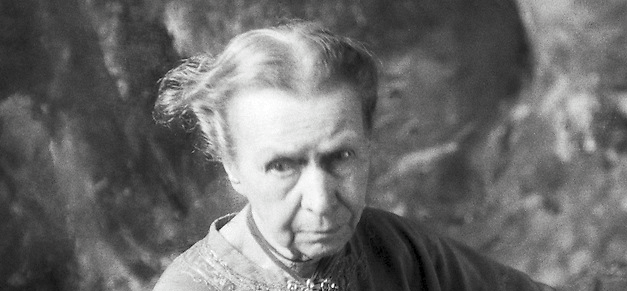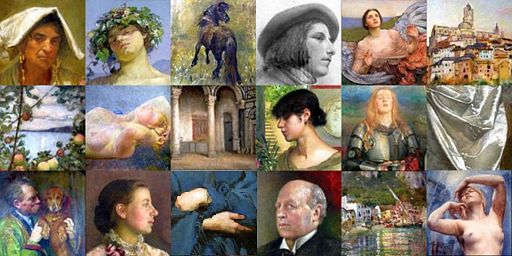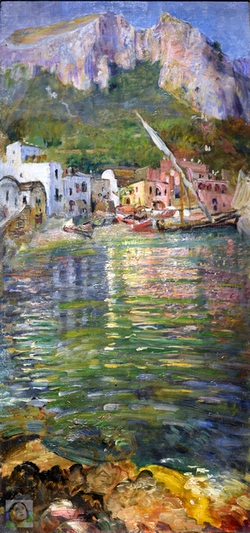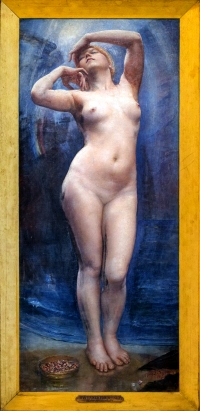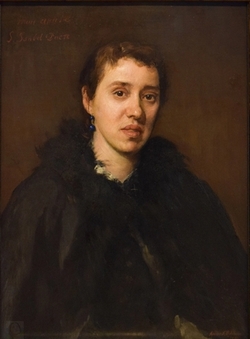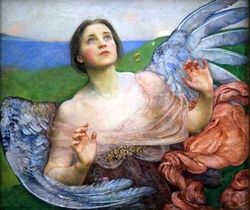This website showcases the work of ANNIE LOUISA SWYNNERTON (née Robinson), the late-19th and early-20th century portrait, landscape and symbolist artist, with additional notes on others in her artistic circle, especially her friend and colleague SUSAN ISABEL DACRE.
[Note: Images at the top of this page are from past, not current, exhibitions at various galleries.]
CLICK HERE FOR THE PICTURES
Born in Manchester, England, in 1844, Annie studied at Manchester School of Art, winning a number of awards, and afterwards spent time studying in France and Italy. In 1879 she co-founded the Manchester Society of Women Painters with her friend Susan Isabel Dacre. In 1883 she married the renowned sculptor Joseph Swynnerton and the couple settled in Rome for most of their working lives. While Annie had works accepted into the permanent national collections of major galleries around the world, she was not formally recognised in her home country until the 1922 when she was admitted to the Royal Academy of Arts, aged 78, the first woman to be accepted since the founding of the Academy in 1768.
Annie was born in a time when access to professional training, gallery representation and membership of art institutions was generally denied to women. They were also disadvantaged by not having easy access to the financial support necessary and were expected to paint a restricted range of subjects, such as flora, portraits or domestic scenes.
… women had to create specific training opportunities for themselves, find artists associations which allowed them to increase their public visibility, and fight for their acceptance in a male-dominated institutionalized exhibition scene. (Nike Seidl (2020) DoME.)
Annie’s ability and creativity challenged the conventions of the time. Not only was her work technically equal to that of her male contemporaries, but she depicted women as independent, assertive and confident individuals, at a time when they were typically portrayed in a passive manner and dependent on men to determine their fates and fortunes.
Unable to develop her skills in Britain’s restrictive environment, Annie and her friend, Susan Isabel Dacre (a remarkable artist in her own right), traveled to the continent to study art in the more liberal atmosphere there, enrolling in the prestigious Academy Julién at one time. She later married Manx sculptor Joseph Swynnerton, who supported her artistic ambitions, and the couple spent much of their working life in the artistic community of Rome.
British galleries consistently rejected Annie’s works for permanent display. While her technical skill was praised, her work just didn’t fit the conventional view of what female artists should be painting or how women should be depicted in art in general. She was, however, being recognized in other countries, with works accepted into permanent collections in the United States, Canada, Ireland, France, South Africa and Australia.
Only much later in life did Annie achieve official recognition in her home country. In 1922, at the age of 78, she became the first woman to be admitted to the Royal Academy of Arts. (Angelica Kauffman and Mary Moser had been founding members in 1768, but were never fully involved in the daily affairs of the institution or elected as such – Annie was the first woman admitted on equal terms to men). She was initially classed a full member, but when it was realised she was beyond the normal cut-off age for admission, 75, she was given the title ‘Senior Associate’ instead and listed above all other ‘Associates’ in exhibition catalogues.
Having only a small number of paintings in public galleries, along with the tendency of institutions and academics to ignore female artists in the late nineteenth and early twentieth centuries, interest in Annie’s work rapidly diminished after her death.
Annie is known to have produced many paintings in her lifetime. Hundreds of works were found in her studios in London and Rome after her death. Most of these quickly disappeared, sometimes being sold as bundles of lots at auction.
She has been termed a ‘symbolist‘, ‘Impressionist‘ or even ‘Pre-Raphaelite‘, but Annie’s work doesn’t neatly fit into any particular category. Influences can be seen and she was at times exhibited alongside some of the most avant-garde artists of her time, but she very much followed her own classically-trained, representational path.
The one sizeable collection of her paintings today is at Manchester Art Gallery – sixteen works – largely thanks to generous bequests made in the 1920s and ’30s. There are twenty-one paintings in other public galleries across Britain, two each in Australia and Canada, and single works in Ireland and France (See ‘works listed by location‘), forty-three altogether.
Images of other, otherwise ‘untraced’ works can been found in old auction catalogues, newspapers and other publications. Pieces occasionally appear at auction, typically once or twice a year. A handful of pieces are known from private or vendor collections which have been loaned to galleries for exhibitions or about which the owners have kindly contacted this web site. The total number of works by Annie for which there are images on this site is now over one-hundred-and-thirty (May 2025).
CAN YOU HELP? It would be wonderful to rediscover some of the lost works of Annie and Isabel.
If you own or know of any works by Annie Louisa Swynnerton (née Robinson) or Susan Isabel Dacre, or have any information or observations of interest, I welcome emails at:
swynnerton.blog@gmail.com
My sole interest is to display images of the works of Annie and Isabel and shed a little extra light on the artistic scene of the period. All communications are treated in strictest confidence. No personal information regarding ownership or location of privately-owned works is ever displayed on this web site.
Recommended reading:
- Christine Allen and Penny Morris (2018) Annie Swynnerton Painter and Pioneer. Sarsen Press.
- Susan Thompson (2018) The Life and Works of Annie Louisa Swynnerton. Manchester Art Press Limited.
- Katie Herrington and Rebecca Milner (2018) Annie Swynnerton: Painting Light and Hope. Manchester Art Gallery.
- Elizabeth Crawford’s web site Woman and Her Sphere contains much information relevant to Annie, her associates and relevant events of the period.
Highly recommended is a visit to Manchester Art Gallery where works by Annie and her circle can be seen on display, Liverpool Art Gallery which has Annie’s Sense of Sight and the Tate which has seven works. Note that only a small number of the paintings held by any gallery are on display at any one time or that works may be on loan to other institutions, but these are all world class galleries with plenty of other wonderful things to see.

About me: my interest in Annie’s work started after visiting the Painting Light and Hope exhibition at Manchester Art Gallery in 2018 and wondering what other works by Annie are still in existence. I created this web site to share my interest and findings, which has since led to the rediscovery of several lost or unknown works and new information about existing ones, as well as an improved appreciation of the work of Susan Isabel Dacre. Other interests include supporting the veterans’ charity I work for, running, travelling, photography and occasionally sketching.
Jonathan Russell, Sep 2025 (swynnerton.blog@gmail.com).
Web site registered 18 Oct 2018. This page last updated 23 Nov 2025.
Management: Morris book.

